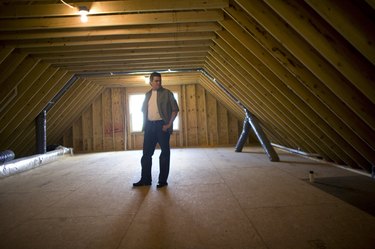
Like many other building materials, insulating spray foams for use on roof rafters and attic surfaces come with advantages and disadvantages. The relatively costly application, for example, can also save money by lowering your energy bills and enabling you to add your own insulation with a contractor's help. Uneven or sloppy application, however, can make the insulation ineffective, and unsealed open-cell insulation can absorb moisture, causing the roof to rot or leak.
Convenience
Video of the Day
Polyurethane or polystyrene spray foams can provide thorough coverage to roof rafters and attic walls in much less time than is needed for other materials. Unlike solid insulation products that require careful measurement, cutting and fitting, spray foam can cover even the most uneven surface instantly. According to Pandi Foam, spray insulation can even help keep old, corroded nails in place. The ease of application also enables homeowners to do the work themselves. Unfortunately, the sheer convenience of this material may encourage sloppy or inexpert application on the part of over-confident amateurs.
Video of the Day
Cost
Spray foam can prove something of double-edged sword where costs are concerned, according to RLC Engineering. While covering a given area with spray foam costs more initially than the equivalent amount of mineral wool batting or other insulating materials, its ability to fill even tiny spaces completely enables it to provide greater thermal resistance, leading to greater energy efficiency and lower utility bills. The fact that you can apply spray foam yourself instead of hiring professional assistance can also allow for significant savings.
Interaction with Moisture
GreenbuildBuildingAdvisor.com notes that spray foam on roof rafters can either resist water vapor or absorb it, depending on whether you use open-cell or closed-cell foam in your installation. While the denser closed-cell variety does not readily absorb moisture, open-cell foam can draw it in like a sponge. The damp foam can then transfer the moisture to rafters and decking materials, leading to rot or leakage. If you use open-cell spray foam on your roof rafters, you should cover the finished application with a paint or sealant that retards water vapor.
Other Considerations
To get the best performance out of spray foam insulation, you must cover the roof rafters and surrounding areas as thoroughly as possible. Even small gaps can allow the passage of warm air through the foam, rendering the foam all but useless as an insulator. You may also need to inspect the foam at intervals to see whether any shrinkage has caused it to pull away from the rafters and leave open spaces.